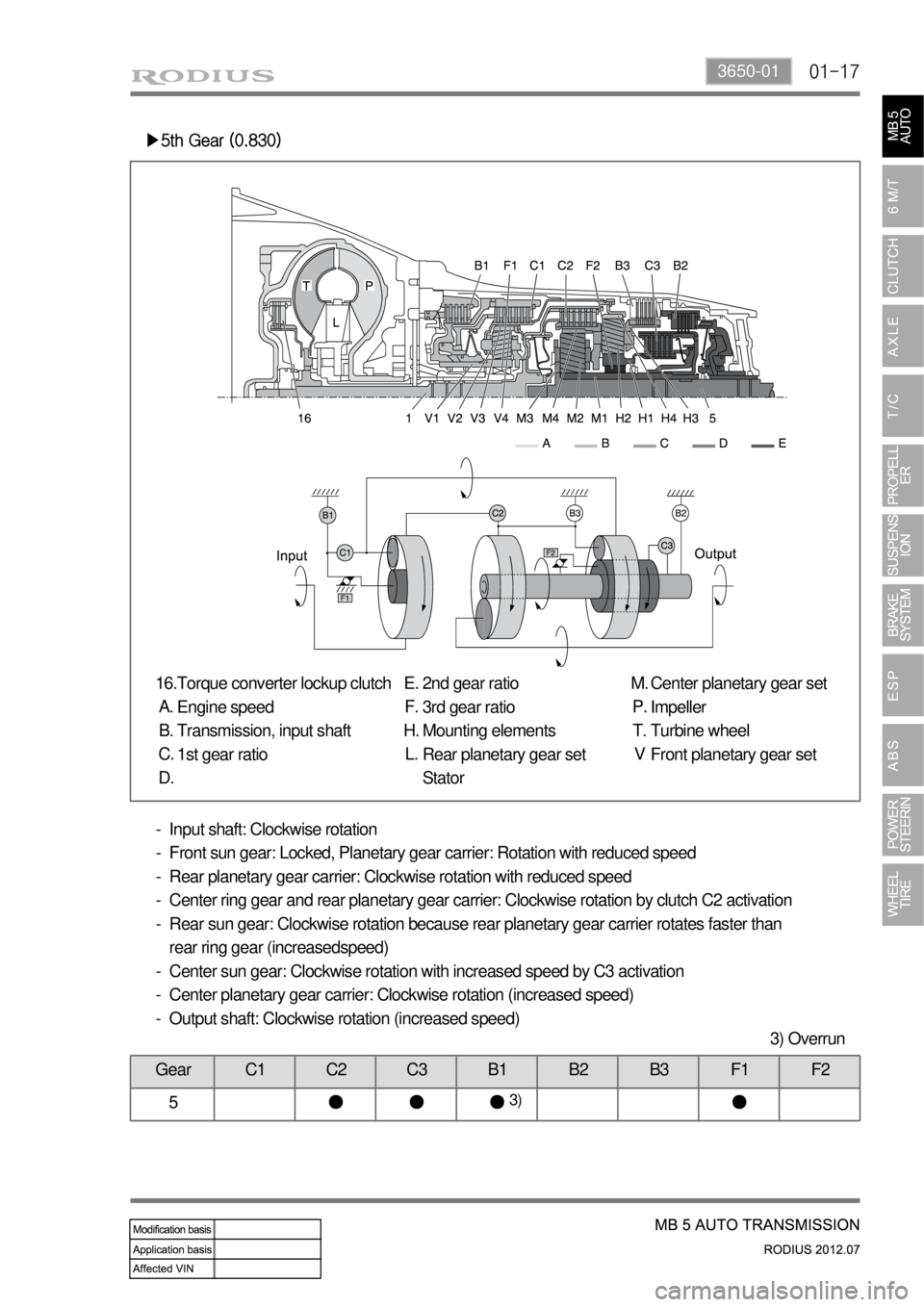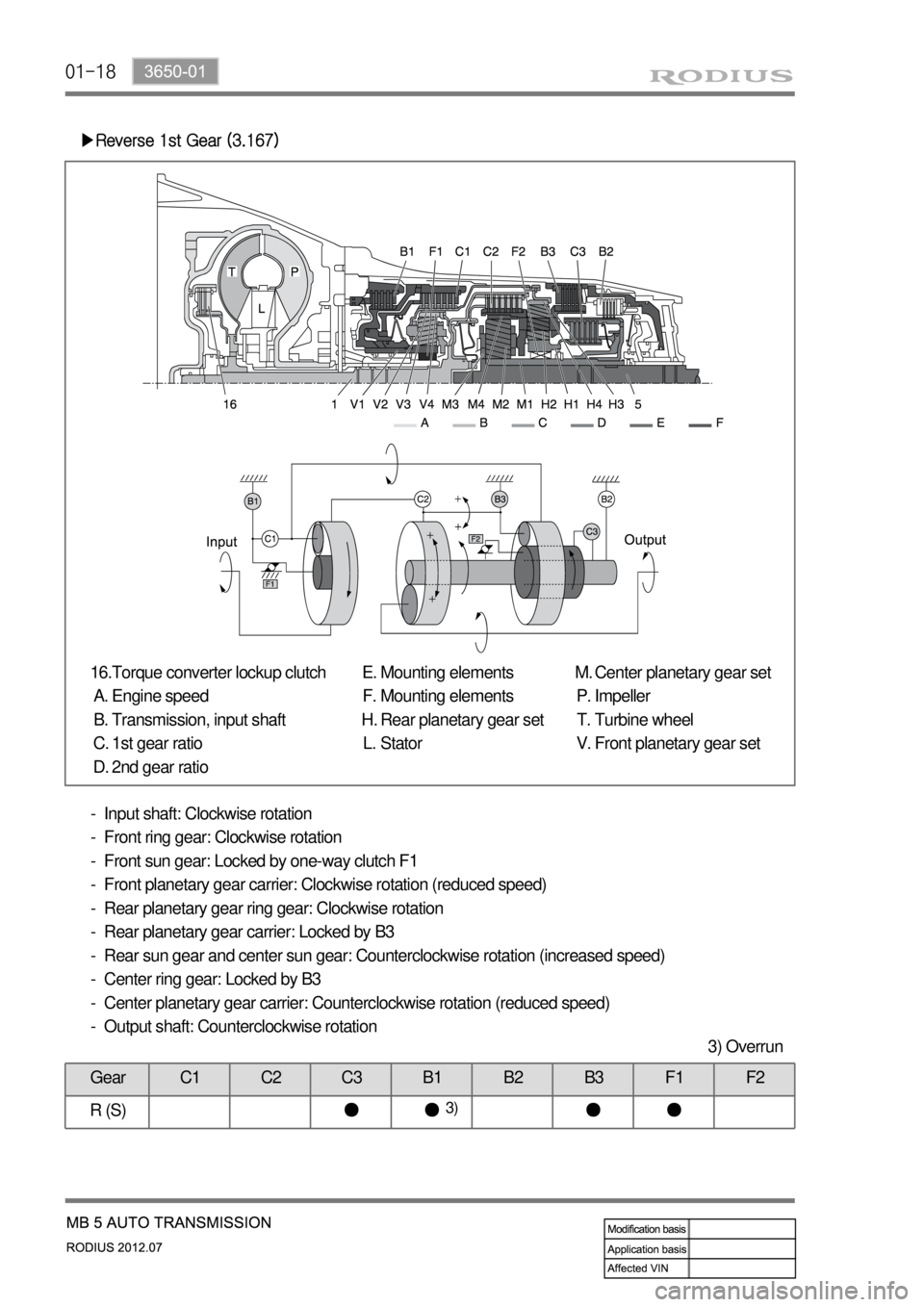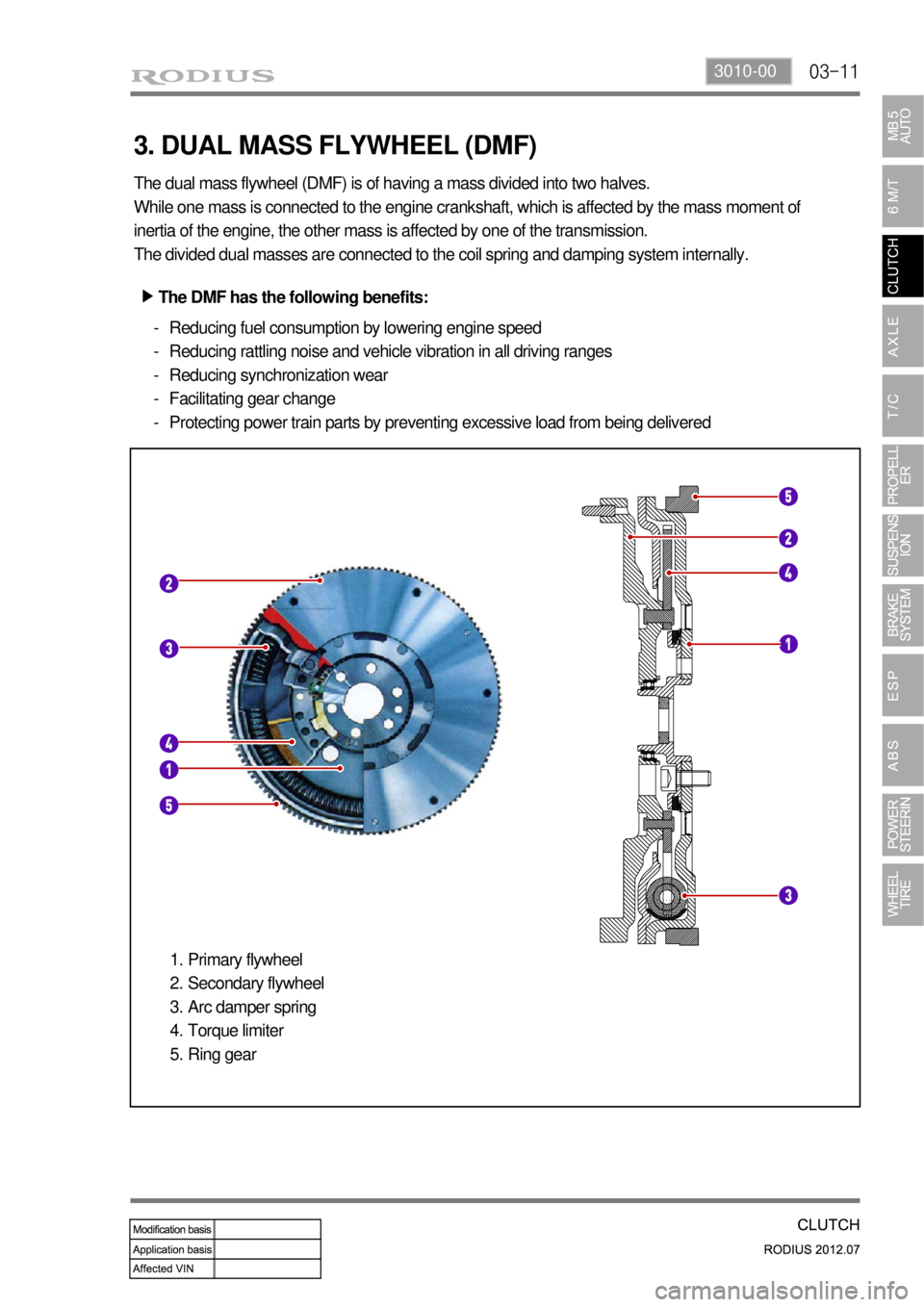engine SSANGYONG RODIUS 2012 Service Manual
[x] Cancel search | Manufacturer: SSANGYONG, Model Year: 2012, Model line: RODIUS, Model: SSANGYONG RODIUS 2012Pages: 715, PDF Size: 79.36 MB
Page 536 of 715

01-173650-01
▶5th Gear (0.830)
Torque converter lockup clutch
Engine speed
Transmission, input shaft
1st gear ratio 16.
A.
B.
C.
D.2nd gear ratio
3rd gear ratio
Mounting elements
Rear planetary gear set
Stator E.
F.
H.
L.Center planetary gear set
Impeller
Turbine wheel
Front planetary gear set M.
P.
T.
V
Input shaft: Clockwise rotation
Front sun gear: Locked, Planetary gear carrier: Rotation with reduced speed
Rear planetary gear carrier: Clockwise rotation with reduced speed
Center ring gear and rear planetary gear carrier: Clockwise rotation by clutch C2 activation
Rear sun gear: Clockwise rotation because rear planetary gear carrier rotates faster than
rear ring gear (increasedspeed)
Center sun gear: Clockwise rotation with increased speed by C3 activation
Center planetary gear carrier: Clockwise rotation (increased speed)
Output shaft: Clockwise rotation (increased speed) -
-
-
-
-
-
-
-
Gear C1 C2 C3 B1 B2 B3 F1 F2
5 ● ● ● ●
3)
3) Overrun
Page 537 of 715

01-18
▶Reverse 1st Gear (3.167)
Torque converter lockup clutch
Engine speed
Transmission, input shaft
1st gear ratio
2nd gear ratio 16.
A.
B.
C.
D.Mounting elements
Mounting elements
Rear planetary gear set
Stator E.
F.
H.
L.Center planetary gear set
Impeller
Turbine wheel
Front planetary gear set M.
P.
T.
V.
Input shaft: Clockwise rotation
Front ring gear: Clockwise rotation
Front sun gear: Locked by one-way clutch F1
Front planetary gear carrier: Clockwise rotation (reduced speed)
Rear planetary gear ring gear: Clockwise rotation
Rear planetary gear carrier: Locked by B3
Rear sun gear and center sun gear: Counterclockwise rotation (increased speed)
Center ring gear: Locked by B3
Center planetary gear carrier: Counterclockwise rotation (reduced speed)
Output shaft: Counterclockwise rotation -
-
-
-
-
-
-
-
-
-
Gear C1 C2 C3 B1 B2 B3 F1 F2
R (S) ● ● ● ●
3)
3) Overrun
Page 538 of 715

01-193650-01
▶Reverse 2nd Gear (1.926)
Torque converter lockup clutch
Engine speed
Transmission, input shaft
1st gear ratio 16.
A.
B.
C.2nd gear ratio
Mounting elements
Rear planetary gear set
Stator D.
E.
H.
L.Center planetary gear set
Impeller
Turbine wheel
Front planetary gear set M.
P.
T.
V.
Input shaft: Clockwise rotation
Front ring gear: Clockwise rotation
Front planetary gear carrier: Clockwise rotation by clutch C1 activation (direct connection)
Rear ring gear: Clockwise rotation
Rear planetary gear carrier and center ring gear: Locked by brake B3
Rear sun gear and center sun gear: Counterclockwise rotation (increased speed)
Center planetary gear carrier: Counterclockwise rotation (reduced speed)
Output shaft: Counterclockwise rotation -
-
-
-
-
-
-
-
Gear C1 C2 C3 B1 B2 B3 F1 F2
R (W) ● ● ●
Page 542 of 715

02-4
2. MAJOR CHANGES
New Transmission (6-speed M/T)
Old (5-speed M/T) New (6-speed M/T)
To maximize the performance of D20DTR engine, new 6-speed manual transmission has been
introduced for 2012 Model.
Rear Mounting Insulator
2WD 6M/T 2WD A/T 4WD A/T
P/N : 3190021M20 P/N : 3190021A20 P/N : 3190021A40
There are three types of rear mounting insulators according to the variations of transmission.
Page 562 of 715

03-53010-00
3. INSPECTION
Pedal stroke and height ▶
Pedal stroke (A) A.
Stop the engine.
Measure the current pedal position.
Depress the clutch pedal all the way and
measure the pedal stroke (A). 1)
2)
3)
Stroke (A)150 ± 3mm
Pedal height (B) B.
Stop the engine.
Remove the floor mat from the driver’s
footwall.
Measure the pedal height (B). 1)
2)
3)
Height (B)95.2 ± 3mm
Adjustment -
Release the lock nut (D) on stopper bolt (C).
Turn the stopper bolt to adjust the pedal
height.
Tighten the lock nut to the specified
tightening torque. 1)
2)
3)
Page 563 of 715

03-6
Pedal free play ▶
Pedal free play (A) A.
Stop the engine.
Measure the current pedal position.
Lightly depress the clutch pedal until you
feel the resistancefrom the pedal and
measure the distance. 1)
2)
3)
Free play (A)5~15 mm
Adjustment -
Release the lock nut (B) from the master
cylinder.
Turn the push rod (C) to adjust the pedal
free play.
Tighten the lock nut to the specified
tightening torque. 1)
2)
3)
Page 564 of 715

03-73010-00
1. OVERVIEW
The hydraulic clutch transmits the force required to operate the clutch pedal to the concentric
slave cylinder fitted to the clutch housing as a hydraulic pressure.
(The hydraulic pressure is transmitted in the following order: Clutch pedal - Clutch master cylinder
- Clutch pipe - Clutch damper - Clutch pipe and hose - Concentric slave cylinder - Pressure
plate - Flywheel.)
If a driver depress the clutch pedal, the hydraulic pressure is generated in the master cylinder. It is
transmitted to the concentric slave cylinder through the pipe, resulting in the cylinder being forced
out. At this time, the clutch disc is forced against the cylinder by pushing the cover. This, in turn,
remove the flywheel from the pressure plate. As a consequence, the power from the engine will be
cut off and the gear change can be carried out.
Page 566 of 715

03-93010-00
2) Overview
Driving elements ▶
The driving elements consist of two flat surfaces machined to a smooth finish.
One of these is the rear face of the engine flywheel and the other is the clutch pressure plate. The
clutch pressure plate is fitted into a clutch steel cover, which is bolted to the flywheel.
Driven elements ▶
The driven element is the clutch disc with a splined hub which is free to slide lengthwise along the
splines of the input shaft.
The driving and driven elements are held in contact by spring pressure. This pressure is exerted
by a diaphragm spring in the clutch cover pressure plate assembly.
Operating Elements ▶
The clutch "release" system consists of the clutch pedal and clutch release cylinder.
This system directly releases the clutch by using hydraulic pressure while the conventional clutch
system releases the clutch by using release lever and release fork. This system provides higher
efficiency than conventional clutch system, and its durability is superior.
Clutch master cylinder (mounted on clutch pedal)
Concentric slave cylinder pipe (mounted inside of transmission) -
-
Page 568 of 715

03-113010-00
3. DUAL MASS FLYWHEEL (DMF)
The dual mass flywheel (DMF) is of having a mass divided into two halves.
While one mass is connected to the engine crankshaft, which is affected by the mass moment of
inertia of the engine, the other mass is affected by one of the transmission.
The divided dual masses are connected to the coil spring and damping system internally.
The DMF has the following benefits: ▶
Reducing fuel consumption by lowering engine speed
Reducing rattling noise and vehicle vibration in all driving ranges
Reducing synchronization wear
Facilitating gear change
Protecting power train parts by preventing excessive load from being delivered -
-
-
-
-
Primary flywheel
Secondary flywheel
Arc damper spring
Torque limiter
Ring gear 1.
2.
3.
4.
5.
Page 569 of 715

04-34120-01
1. SPECIFICATIONS
Front Axle ▶
Rear Axle ▶
Description Specification
Drive shaft type CV joint
Axle housing type Build up
DifferentialType Conventional type
Gear type Hypoid Gear
Final gear reduction ratioEngine + M/T 3.54
Engine + A/T 4.55
OilCapacity 1.2L
Specification SAE 80W / 90
Description Specification
Axle shaft type Semi-floating
Axle housing type Build up
DifferentialType Conventional type
Gear type Hypoid Gear
Final gear reduction ratioEngine + M/T 3.54
Engine + A/T 4.55
OilCapacity 1.7L
Specification SAE 80W / 90